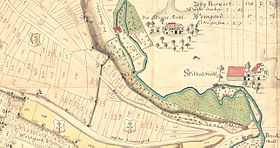Spitalmühle (Markgröningen)
The Spitalmühle is a flour mill on the Glems - above the Markgröningen district of Talhausen in the Ludwigsburg district .
history
The first evidence of the hospital mill originally belonging to the Markgröninger Heilig-Geist-Spital comes from the year 1416. The tenants of hospital goods as well as everyone who received field crops from the hospital as remuneration in kind had to have them milled in this mill. But the lease fees were too hard and drove 22 millers into ruin in the following 130 years. The mill was completely destroyed in the Thirty Years War . After several unsuccessful attempts by the city hospital administration since the Reformation, it won Hans Conrad Schell over to rebuild it in 1680. However, this failed due to the consequences of the French invasions and was soon lost. This was followed by a number of other millers at short intervals, who soon had to give up again because of the traditionally high charges to the hospital administration. In 1817 the brothers Johann Michael and Ernst Gottfried Weizsäcker sold the mill to "Johann Georg Frick and his wife Katharina", whose descendants have been able to maintain themselves as "Spitalmüller" to this day.
Forced laborers who had not yet returned home from Poland and Russia undertook raids in the vicinity of Markgröningen after the Second World War , for example on the Nippenburg , on the Aichholzhof and in Talhausen . On the night of November 10, 1945, the hospital mill was attacked by Poles. They drove all the residents they could find into the basement and shot them in the head there. An employee had hidden in time. A daughter of the Müller family survived because she was on a free time. The gang were caught and detained by the American military police in 1946 . The two alleged gunmen were executed.
Equipment and operation
At the beginning of the 19th century the mill had three overshot water wheels, which were fed by the 286 meter long canal that branched off from Vaihinger Straße below the Glemsbrücke. In 1905 the mill belonged to Hermann Frick and was driven by two overshot water wheels, each 2.23 m in diameter and 1.80 m and 1.86 m wide. They used a gradient of 2.70 m and delivered a raw power of 12.6 hp at 350 l / s water flow. In 1921/22 Mina Frick replaced the two water wheels with a Haag twin submersible turbine and a Francis turbine. These two turbines were later expanded and replaced in 1976 by a single Ossberger turbine with a maximum output of 19.2 hp.
The Spitalmühle owned by the Frick and Kefer families was the only mill in Markgröningen that survived into the 21st century in its original form as a grain mill. She last worked with three double roller mills and a stone grinding gear for grinding and had a grinding capacity of 7.5 tons per day (as of 1997). Milling has now ceased. But the owners still sell flour directly to private customers.
An information board presents the mill as a station on the Glemsmühlenweg , established in 2001 .
literature
- Markgröningen - people and their city. Comprehensive presentation of the city's recent history in approx. 60 individual articles . Volume 6 of the series "Durch die Stadtbrille", ed. v. Working Group on Historical Research, Heritage and Monument Preservation Markgröningen, 477 p., Markgröningen 2000
- Millers, mills, hydropower . Volume 5 of the series "Through the city glasses, history and stories about Markgröningen", ed. v. Working group for historical research, heritage and monument preservation Markgröningen, 181 p., Markgröningen 1995
- Thomas Schulz: Mühlenatlas Baden-Württemberg , Vol. 3 The mills in the Ludwigsburg district , Manfred Hennecke publishing house, 1999, Remshalden-Buoch, ISBN 3-927981-63-X
Individual evidence
- ↑ Source: Aussfeld map from 1752 ( landesarchiv-bw.de - N 1 No. 85 )
- ↑ Hilde Fendrich: Nulla calamitas sola - a misfortune rarely comes alone. In: Müller, Mühlen, Wasserkraft , Volume 5 of the series Through the city glasses, history and stories around Markgröningen , ed. v. Working group for historical research, heritage and monument preservation Markgröningen, Markgröningen 1995, p. 52ff.
- ↑ See Hilde Fendrich in: Markgröningen - people and their city. Comprehensive presentation of the city's recent history in approx. 60 individual articles . Volume 6 of the series "Durch die Stadtbrille", ed. v. Working group for historical research, heritage and monument preservation Markgröningen, p. 355ff.
- ↑ 1200 years of Markgröningen. Festival book for the 1200th anniversary of the first written mention of the name. Ed .: Stadt Markgröningen, Markgröningen 1979, p. 98.
See also
Web links
- Map and information about the Glemsmühlenweg
- List of cultural monuments in Markgröningen (2011) (PDF; 33 kB)
Coordinates: 48 ° 54 '11.9 " N , 9 ° 4' 17.4" E

